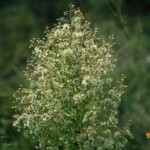Coulter Conyza, Horsetail Conyza
Laennecia courlteri
Asteraceae (Sunflower Family)
Description
Laennecia courlteri is an herbaceous, 3 to 6 ft or 100 to 150 cm tall annual of the Sunflower family (Asteraceae) and has a definite taproot. Its stems are covered with sticky hairs giving it a spider web resemblance. Proximal leaves are broadly spatulate to oblong and two to five cm long by one to two cm wide. The distal leaves tend to be smaller, oblong to elliptical, and one to two cm long by three to ten mm wide. The leaves are arranged alternately and have coarsely toothed and sometimes lobed margins. The many-flowered heads grow in leafy spreading branches or clusters, becoming feathery white after flowering. These heads are about 5 mm tall and cream-colored containing 60-100 pistillate flowers with white corollas but lacking ray petals and 5 to 20 whitish disk florets. Bloom time can range from spring to fall with fall being the most typical. The flowers produce tiny cypsela (I.e., a dry, single-seeded, non-opening fruit with fused bristles).Habitat
Laennecia courlteri is confined to the western third of the state. It is commonly found in disturbed sites, stream banks, roadsides, and fields.Toxic Agent
The toxic agent of these plants is unknown. Laennecia courlteri has poisoned sheep, goats, and cattle in experimental trials. During drought, this plant has been responsible for serious losses of cattle in the Trans-Pecos region. Horsetail Conyza has not been fed experimentally, but cattle and goats have been lost after consuming the plant. Both result in polioencephalomalacia. Kingsbury, on pg. 397 Plants of the United States and Canada, reported fresh green leaves force-fed to lambs (3% of body weight) resulted in death in three days.Signs of Livestock Ingestion
Clinical signs associated with poisoning by these plants are related to brain damage and may include: Walking in circles; Hyperexcitability; Muscle tremors; Apparent blindness; Coma; Death. If begun early enough, treatment with thiamine may reverse the condition.Management Strategies
Laennecia courlteri is unpalatable, and livestock eat it only when forced. Laennecia courlteri is normally a problem in a drought when the plants are young, and forage is limited. Horsetail is usually consumed only after it is treated with the herbicide 2,4-D. Do not allow animals access to treated plants until the plants are dead and dry. These plants readily invade disturbed areas and often increase after mechanical brush control has disturbed the soil. Laennecia courlteri has increased where Spike 20P® was used to control woody plants.Images
Plant Characteristics
Flower Color: White
Seed Type: Cypsela
Duration: Annual
Stem Texture: Hairy
Growth Habit: Forbs/Broadleaf
Leaf Shape
 : Simple with Pinnate or Parallel Venation
: Simple with Pinnate or Parallel Venation
Season: Warm
Distribution
 : 02 - Gulf Prairies and Marshes, 06 - South Texas Plains, 07 - Edwards Plateau, 09 - High Plains, 10 - Trans-Pecos
: 02 - Gulf Prairies and Marshes, 06 - South Texas Plains, 07 - Edwards Plateau, 09 - High Plains, 10 - Trans-Pecos
Distributions
Distribution refers to the ecological region in Texas that a plant has been found. You can also view a clickable map.
Book: Toxic Plants of Texas (B-6105)
Collection: Toxics
Livestock Affected: Cattle, Goats, Sheep
Livestock Signs: Blindness, Coma, Continuous Walking, Excitability, Trembling








